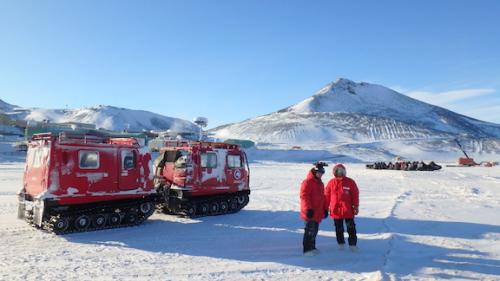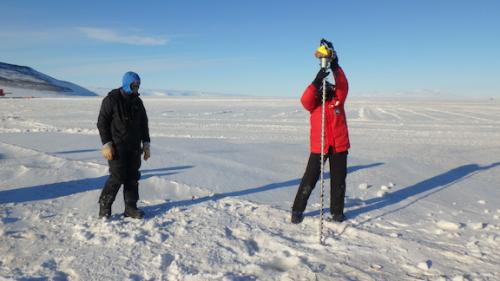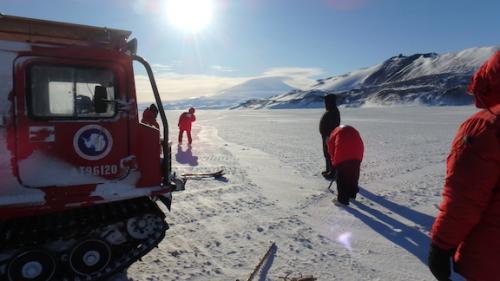Pegasus Field is 9 miles North of McMurdo Station and Ross Island, well out into the Ross Sea. The airfield sits on an ice shelf, a thick tongue of glacial ice flowing out of the mountains and down into the ocean where it persists throughout the year. Ice shelves like this are just one of many varieties of ice, each with very different physical properties. Some, like the floating arms of glaciers, can be hundreds of feet thick and can easily support a three hundred thousand pound aircraft. Others, like the ices that form from freezing seawater, are constantly moving, cracking, and changing, occasionally even exposing open water. Out on the frozen ocean, being able to recognize the subtle characteristics of the ice you're travelling on can keep you from experiencing a really bad day.
 Tracked vehicles like this Haglunds are the primary means of traversing the sea ice between field sites.
Tracked vehicles like this Haglunds are the primary means of traversing the sea ice between field sites.
Ben Atkison is McMurdo Station's Sea Ice Point of Contact for the summer research season. His job is to scout out the safest routes across the ice between different field camps, monitoring the known cracks for changes that may make them hazardous to McMurdo's tracked vehicle fleet. This is a huge undertaking: the ice thickness and hardness deteriorates with increasing summer sunlight and the ocean currents beneath drag and destabilize the entire sheet. By the height of the summer, the ice around McMurdo - which currently appears so endless and permanent - will give way to open water. Before that happens, the land-sea transition areas will become impassible and all equipment staged on the ice will need to come back onto land. Part engineer and part meteorologist, Ben is here to keep everyone up to date on what's happening out on the ice.
 Sea Ice POC Ben Atkison instructs a course participant in proper ice drilling technique.
Sea Ice POC Ben Atkison instructs a course participant in proper ice drilling technique.
Ben is also our instructor for Sea Ice Safety, a field course that teaches us how to interpret the various features we might encounter crossing the sea ice to get to our dive sites. Over the course of a full day in the field, we learn to spot cracks, probe them for open water hidden under snow, measure the gap width, evaluate the ice thickness using gas powered drills and measuring tape, and then finally make the call about whether it's safe to cross. Safety is the primary goal but efficient travel between sites is important as well and Ben teaches us several tricks to keep us moving. The cracks appear like subtly smooth walking paths among the ripples and scales of the ice field. I'm a little apprehensive about my ability to detect them when we're out on the ice alone but I'm confident in the team's collective experience. Today, I'm also so very happy to be outside in this magnificent seascape. Conditions are sunny with calm winds and a high of -8F. Glorious!
 With lenticular clouds forming over Mt Erebus in the distance, course participants prepare to evaluate a sea ice crack.
With lenticular clouds forming over Mt Erebus in the distance, course participants prepare to evaluate a sea ice crack.

Comments